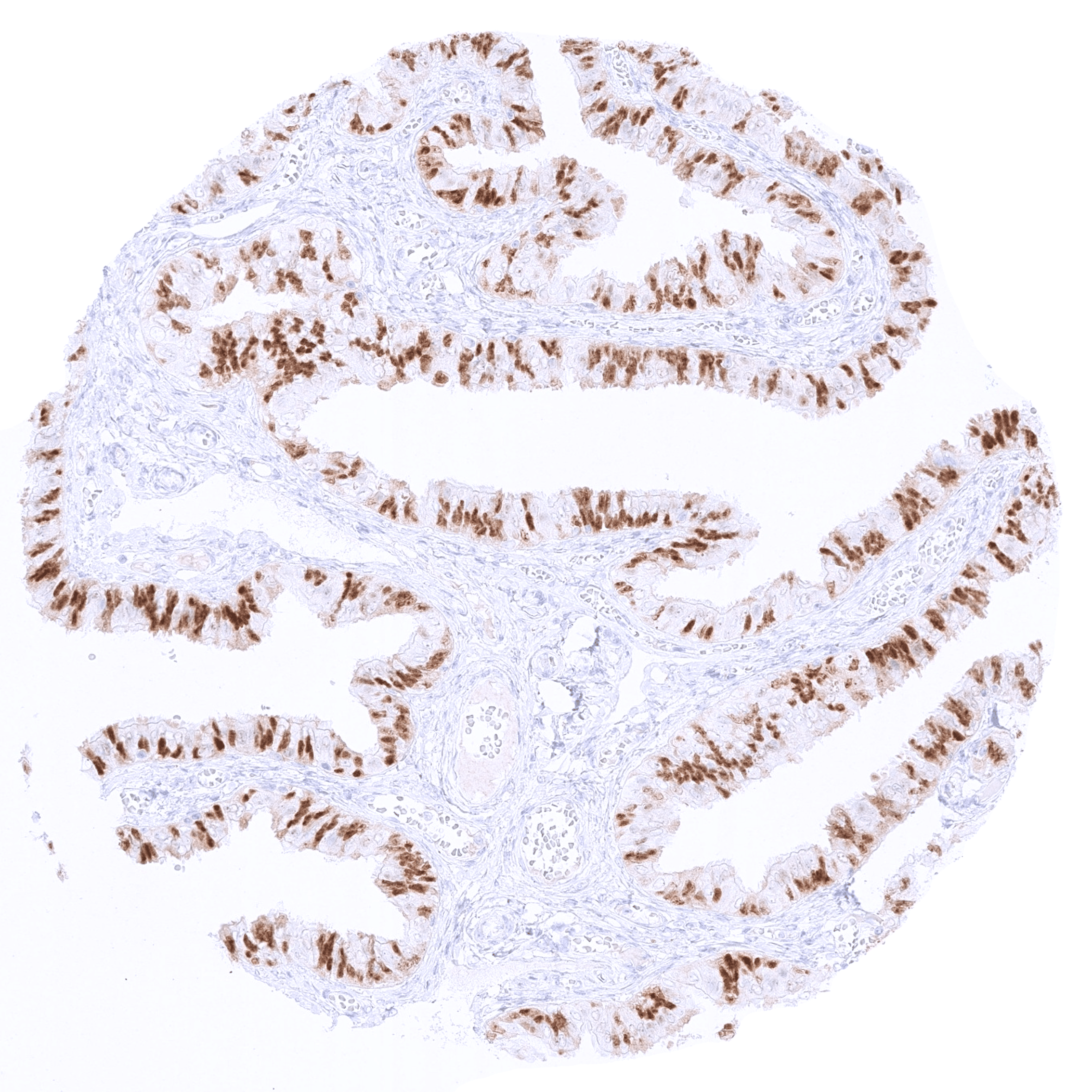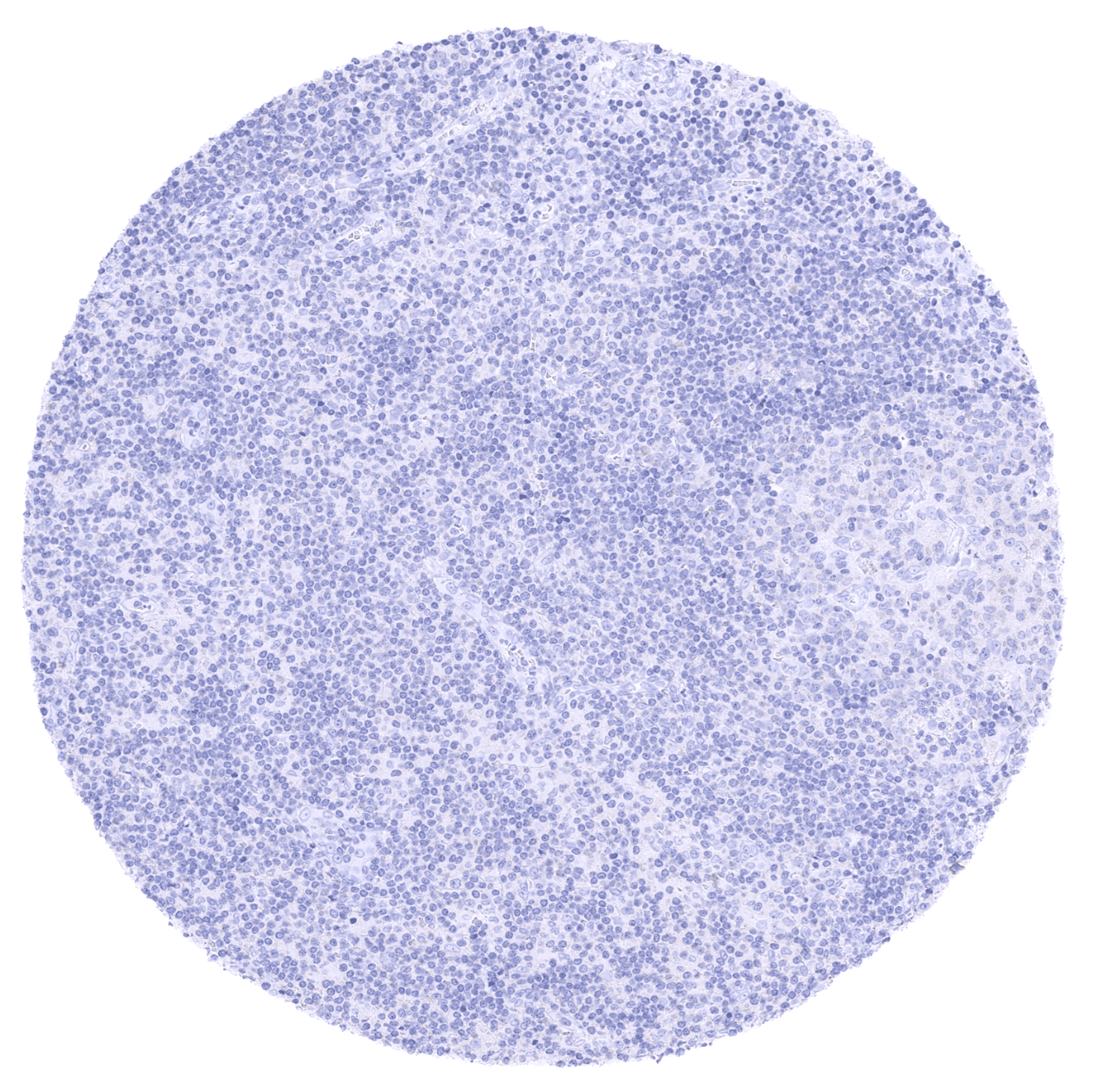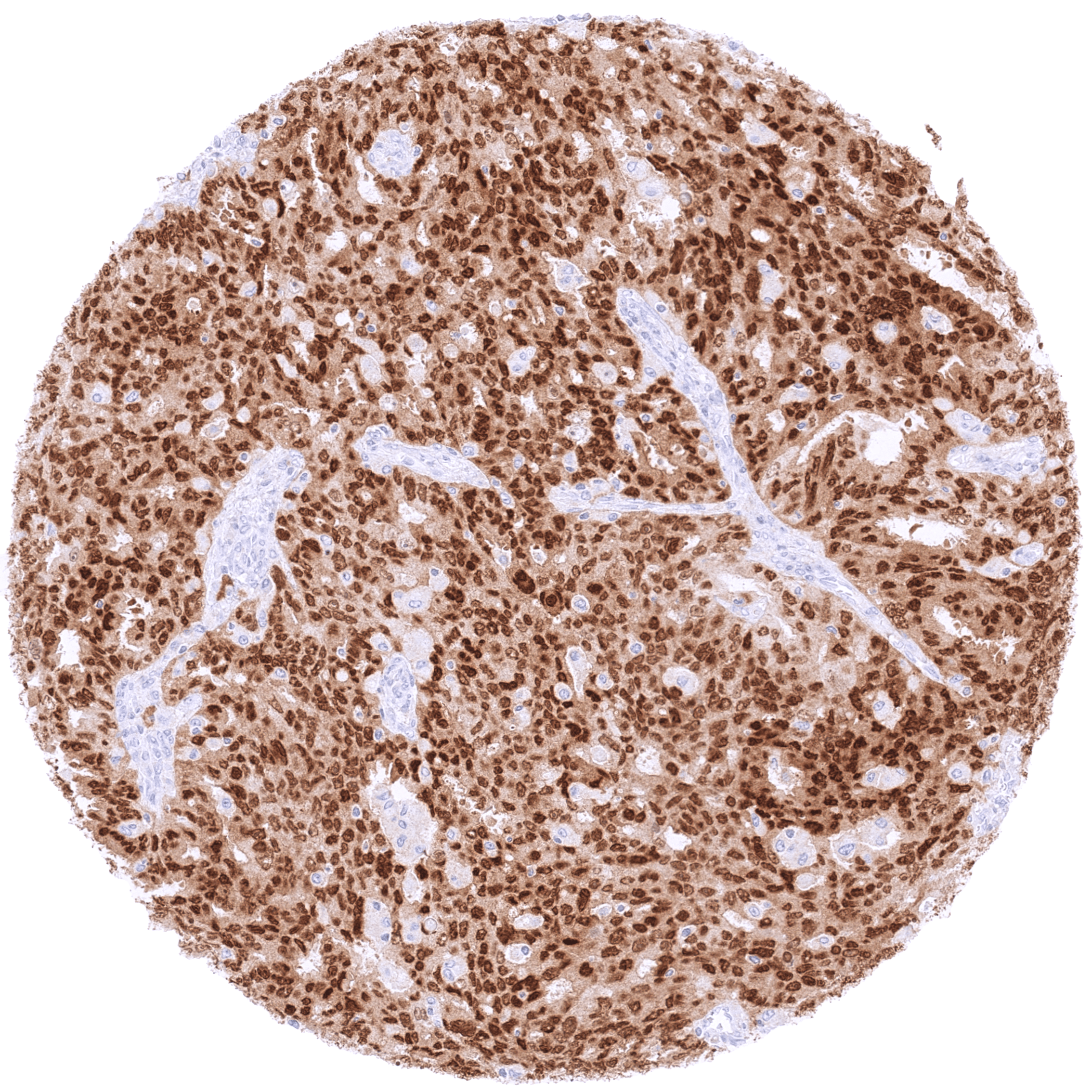295,00 € – 995,00 €
Product details
Synonyms = Paired box gene 8; Paired domain gene 8; PAX8; paired box homeotic gene 8
Antibody type = Recombinant Rabbit monoclonal / IgG
Clone = MSVA-708R
Positive control = Kidney: At least weak to moderate, distinct nuclear staining should be seen in the majority of epithelial cells of the proximal and distal renal tubules, collection ducts, and the parietal epithelial cells of the Bowman’s capsule.
Negative control = Tonsil: No staining should be seen in squamous epithelial cells and in lymphocytes.
Cellular localization = Nuclear
Reactivity = Human
Application = Immunohistochemistry
Dilution = 1:100 – 1:200
Intended Use = Research Use Only
Relevance of Antibody
PAX8 is a marker for kidney, thyroid and Mueller tract tissues.
Biology Behind
PAX8 (Paired box gene 8) is a member of the paired-box gene family. The 48kDa protein is coded by the PAX8 gene at chromosome 2q14.1. PAX8 is physiologically expressed in organ development of the thyroid, Wollffian and Muellerian tract, renal/upper urinary tract, and the inner ear, and is also required for tissue homeostasis in the respective adult tissue. PAX8 is a master transcriptional regulator of thyroid specific genes such as thyroglobulin, thyroid peroxidase, and the sodium-iodide symporter by binding to the promoter regions. In Wollffian and Muellerian duct derived tissues, PAX8 is important for mesenchymal-to-epithelial transition and regulates branching morphogenesis and nephron differentiation. PAX8 may also modulate WT1 transcription. Inherited PAX gene deficiencies can result in congenital hypothyroidism and in genitourinary development defects (Congenital Anomalies of the Kidney and Urinary Tract; CAKUT).
Staining Pattern in Normal Tissues
PAX8 immunostaining preferably occurs in epithelial cells of the kidney, endometrium, endocervix, fallopian tube, and in follicular cells of the thyroid. Images describing the PAX8 staining pattern in normal tissues obtained by the antibody MSVA-708R are shown in our “Normal Tissue Gallery”.
| Brain | Cerebrum | Negative. |
| Cerebellum | Negative. | |
| Endocrine Tissues | Thyroid | Strong nuclear and also a variable cytoplasmic PAX8 staining of follicular cells. |
| Parathyroid | Negative. | |
| Adrenal gland | Negative. | |
| Pituitary gland | Negative (for nuclear staining). A weak to moderate (non-specific), purely cytoplasmic PAX8 staining can occur in a subset of epithelial cells. | |
| Respiratory system | Respiratory epithelium | Negative. |
| Lung | Negative. | |
| Gastrointestinal Tract | Salivary glands | Negative. |
| Esophagus | Negative. | |
| Stomach | Negative (for nuclear staining). A faint non-specific and purely cytoplasmic PAX8 staining can occur in stomach glands. | |
| Duodenum | Negative. See remarks. | |
| Small intestine | Negative. See remarks. | |
| Appendix | Negative. | |
| Colon | Negative. | |
| Rectum | Negative. | |
| Liver | Negative. | |
| Gallbladder | Negative. A faint non-specific) cytoplasmic staining can occur in epithelial cells. | |
| Pancreas | Negative. | |
| Genitourinary | Kidney | Variable, weak to strong nuclear PAX8 staining of cells of proximal and distal tubuli, collecting ducts, and of epithelial cells of the Bowman’s capsule. Some cytoplasmic staining also occurs in these cells. |
| Urothelium | PAX8 staining is usually absent in urothelium, but a weak to moderate PAX8 positivity can occasionally occur in basal and suprabasal cell layers, especially in the kidney pelvis. | |
| Male genital | Prostate | Negative. |
| Seminal vesicles | Variable, weak to strong nuclear PAX8 staining of epithelial cells, often accompanied by some cytoplasmic staining. | |
| Testis | Negative. | |
| Epididymis | Variable, usually strong nuclear PAX8 staining of epithelial cells in the cauda and the caput epididymis. | |
| Female genital | Breast | Negative. |
| Uterus, myometrium | Negative. | |
| Uterus, ectocervix | Negative. | |
| Uterus endocervix | Strong nuclear PAX8 staining of epithelial cells. | |
| Uterus, endometrium | Variable, usually strong nuclear PAX8 staining of endometrial cells while stroma cells remain negative. | |
| Fallopian Tube | Strong nuclear PAX8 staining of a subset of epithelial cells of the fallopian tube | |
| Ovary | Negative. | |
| Placenta early | Negative. | |
| Placenta mature | Negative. | |
| Amnion | Negative. | |
| Chorion | Negative. | |
| Skin | Epidermis | Negative. |
| Sebaceous glands | Negative. | |
| Muscle/connective tissue | Heart muscle | Negative. |
| Skeletal muscle | Negative. | |
| Smooth muscle | Negative. | |
| Vessel walls | Negative. | |
| Fat | Negative. | |
| Stroma | Negative. | |
| Endothelium | Negative. | |
| Bone marrow/lymphoid tissue | Bone marrow | Negative. |
| Lymph node | Negative. | |
| Spleen | Negative. | |
| Thymus | Negative. | |
| Tonsil | Negative. | |
| Remarks | Nuclear staining obtained by MSVA-708R is completely specific for PAX8. A (non-specific) cytoplasmic staining occurs in a small subset of inflammatory cells, especially in the small intestine as well as few other tissues. |
These findings are largely consistent with the RNA data described in the Human Protein Atlas (Tissue expression PAX8).
Positive control = Kidney: At least weak to moderate, distinct nuclear staining should be seen in the majority of epithelial cells of the proximal and distal renal tubules, collection ducts, and the parietal epithelial cells of the Bowman’s capsule.
Negative control = Tonsil: No staining should be seen in squamous epithelial cells and in lymphocytes.
Staining Pattern in Relevant Tumor Types
PAX8 expression primarily occurs in carcinomas derived from the thyroid, kidney, ovary, and the endometrium. At lower frequency, PAX8 expression also occurs in tumors from various other organs of origin.
The TCGA findings on PAX8 RNA expression in different tumor categories have been summarized in the Human Protein Atlas.
Compatibility of Antibodies
PAX8 (MSVA-708R) publication summary
Relevant publication: Gorbokon et al. “PAX8 expression in cancerous and non-neoplastic tissue: a tissue microarray study on more than 17,000 tumors from 149 different tumor entities.” Published in Virchows Arch. 2024 Aug 6. doi: 10.1007/s00428-024-03872-y. Epub ahead of print. PMID: 39105782.
A total of 15’223 tumors from 149 different tumor categories were successfully analyzed by using the following protocol: Heat-induced antigen retrieval for 5 minutes in an autoclave at 121°C in pH 7,8 Target Retrieval Solution buffer. MSVA-708R, at a dilution of 1:150 at 37°C for 60 minutes. Visualization of bound antibody by the EnVision Kit (Dako, Agilent). This protocol was also used for all stainings depicted in our tumor and normal tissue galleries.
A detectable PAX8 expression was found in 40 of 149 tumor categories and 32 tumor categories included at least one case with strong PAX8 positivity. The PAX8 positivity rate was highest in thyroidal neoplasms of follicular origin (98.6–100%), gynecological carcinomas (up to 100%), renal neoplasms (82.6–97.8%), and urothelial tumors (2.3–23.7%). Important tumor entities with near complete absence of PAX8 staining (< 1%) included all subtypes of breast cancers, hepatocellular carcinomas, gastric, prostatic, pancreatic, and pulmonary adenocarcinomas, neuroendocrine neoplasms, small cell carcinomas of various sites, and lymphomas. The complete results are shown in an “organ-systematic” (Figure 1) and in a “ranking order” figure (Figure 2) below (images based on data from Gorbokon et al). Data on associations with histopathological and clinical parameters are also summarized below (Table 3; based on data described by Gorbokon et al).
Authors conclusions on diagnostic utility of MTAP IHC with respect to the distinction of benign versus malignant (Gorbokon et al):
- not applicable.
Authors conclusions on diagnostic utility of MTAP IHC with respect to the distinction of different tumor entities (Gorbokon et al):
- PAX8 is a marker for tumors derived from the kidney, the thyroid, and the female genital tract.
Authors conclusions on the prognostic/predictive role of MTAP IHC results (Gorbokon et al):
- high level PAX8 expression is associated with low grade in non-invasive (p<0,0001) and invasive (p<0,05) urothelial carcinoma (p<0,05).
- high level PAX8 expression is associated with low pT stage in clear cell renal cell carcinoma (p<0,05).
Data from the publication: PAX8 expression in cancerous and non-neoplastic tissue: a tissue microarray study on more than 17,000 tumors from 149 different tumor entities. Published by Gorbokon et al. in Virchows Arch. 2024 Aug 6. doi: 10.1007/s00428-024-03872-y. Epub ahead of print. PMID: 39105782.
Summarized in own graphics:
1. PAX8 staining in tumors “organ-specific” with antibody MSVA-708R
2. PAX8 staining in tumors “ranking order” by positivity with antibody MSVA-708R.
Protocol Recommendations
IHC users have different preferences on how the stains should look like. Some prefer high staining intensity of the target stain and even accept some background. Others favor absolute specificity and lighter target stains. Factors that invariably lead to more intense staining include higher concentration of the antibody and visualization tools, longer incubation time, higher temperature during incubation, higher temperature and longer duration of the heat induced epitope retrieval (slide pretreatment). The impact of the pH during slide pretreatment has variable effects and depends on the antibody and the target protein.
All images and data shown here and in our image galleries are obtained by the manual protocol described below. Other protocols resulting in equivalent staining are described as well.
Manual protocol
Freshly cut sections should be used (less than 10 days between cutting and staining). Heat-induced antigen retrieval for 5 minutes in an autoclave at 121°C in pH 7,8 Target Retrieval Solution buffer. Apply MSVA-708R at a dilution of 1:150 at 37°C for 60 minutes. Visualization of bound antibody by the EnVision Kit (Dako, Agilent) according to the manufacturer’s directions.
Potential Research Applications
- The role of PAX8 in tumor biology – especially for epithelial mesenchymal transition – is under investigation.
- The utility of PAX8 as a therapeutic target is being studied.
- A possible role of PAX8 as an inducer of angiogenesis is being considered.
Evidence for Antibody Specificity in IHC
There are two ways how the specificity of antibodies can be documented for immunohistochemistry on formalin fixed tissues. These are: 1. Comparison with a second independent method for target expression measurement across a large number of different tissue types (orthogonal strategy), and 2. Comparison with one or several independent antibodies for the same target and showing that all positive staining results are also seen with other antibodies for the same target (independent antibody strategy).
Orthogonal validation: For the antibody MSVA-708R specificity for detection of PAX8 is suggested by the strong concordance of the immunostaining data with data from three independent RNA screening studies, including the Human Protein Atlas (HPA) RNA-seq tissue dataset, the FANTOM5 project, and the Genotype-Tissue Expression (GTEx) project, which are all summarized in the Human Protein Atlas (Tissue expression PAX8). PAX8 positivity by MSVA-708R is detectable in all tissues with documented PAX8 RNA expression (kidney, epididymis, seminal vesicle, endometrium, cervix uteri, fallopian tube, thyroid). All tissues without previously documented PAX8 RNA expression did not show a positive nuclear immunostaining by MSVA-708R.
Comparison of antibodies: True expression of PAX8 in all cell types for which a nuclear PAX8 positivity was seen by MSVA-708R is corroborated by confirmation of all nuclear PAX8 stainings obtained by MSVA-708R by another commercially available independent antibody (termed “validation antibody”). That the second antibody also showed nuclear staining of lymphocytes and other tissues for which a nuclear staining was not seen by MSVA-706R, documents the independent nature of the validation antibody. These nuclear stainings of the validation antibody are considered antibody specific cross-reactivities. Some purely cytoplasmic stainings seen by MSVA-708R in few inflammatory cells of the intestine, a subset of cells of the adenohypophysis, gallbladder epithelium and gastric glands are also considered cross-reactivities. These, however, cannot cause interpretation issues because they are not nuclear.
Antibody Comparison: MSVA-708R vs another commercial anti-PAX8 antibody called “validation antibody”








































